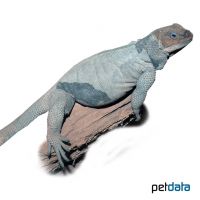Spiny Chuckwalla (Sauromalus hispidus)
| Spiny Chuckwalla Sauromalus hispidus | |
|---|---|
| Name | Spiny Chuckwalla |
| Name Lat. | Sauromalus hispidus |
| Family | Iguanas |
| Family lat. | Iguanidae |
| Order | Scaled Reptiles |
| Order lat. | Squamata |
| Origin | Mexico |
| Habitat | Semi-desert |
| Diet | Veggies, insects |
| Humidity | 30-50 % |
| Behavior | ♂ territorial |
| Keeping | Pair, harem |
| Care Level | Moderate |
| Reproduction | Oviparous |
| Housing | Desert terrarium |
| Life Span | 20 years |
| Protection | No |
| Metric Units | |
| Size | 60 cm |
| Temperature | 25-30 °C |
| Temperature Local | 45-50 °C |
| Housing Size | 200 x 120 x 160 cm |
| US Units | |
| Size | 24" |
| Temperature | 77-86 °F |
| Temperature Local | 113-122 °F |
| Housing Size | 80" x 45" x 65" |
Distribution and habitat
The diurnal giant spiny chuckwalla are endemic to the dry, hot and rocky islands off Baja California, Mexico, in the northwestern Gulf of California. At night, but also during the day for thermoregulation, they retreat into rock crevices and caves.
Maintenance
Minimum dimensions for the terrarium, according to the size and number of animals
| 1-2 animals | 5KRL x 4KRL x 3KRL or 5KRL x 3KRL x 4KRL (L x W x H) |
Head-torso length (KRL) is measured on the largest animal. For each additional animal, increase the footprint by 15%. A terrarium of e.g. L 200 x W 120 x H 160 cm is recommended, which should be placed in a quiet and vibration-free place.
They need a well structured terrarium with strong climbing branches, stones and firmly cemented rock constructions with horizontal crevices (hiding places) at the back and side walls as well as an approx. 30 cm deep, diggable substrate of sand-clay mixture to be able to build constructions. A small part of the substrate should always be kept moist. A small water container and an easy-to-clean feeding station complete the setup. Once or twice a week, preferably in the evening, the inside of the terrarium should be finely sprayed with water
| Temp. day: 25-30 °C | Temp. night: 20-25 °C | Temp. local: up to 50 °C | Humidity: 30-50 |
Thermostatically controlled floor heating is recommended. Lighting duration must be 12-14 hrs depending on the season. They need a high light intensity. Special lamps that produce the necessary heat and UV light are ideal. Daily UV irradiation is essential.
Diet
They require mainly plant food. The food supply consists of wild herbs (alfalfa, dandelion, ribwort, clover, cress, parsley, etc.), vegetables (lettuce, peppers, zucchini, tomatoes, cabbage, etc.), sprouts and germs of e.g. corn, lentils, mung beans and alfalfa, various flowers (dandelion, evening primrose, clover, daisies) and fruits. Occasionally, live insects such as crickets and grasshoppers may be offered. Young animals feed exclusively on a vegetarian diet. It is important to add minerals and vitamins (dusting the food). Young animals should be offered food daily, adults 3-4 times a week. Drinking water must always be available. A varied diet promotes health and prevents deficiency symptoms.
Reproduction and breeding
Only males have femoral pores on the inner thigh of their hind legs. The female lays about 8-10 hard-shelled eggs in the substrate several times a year. At a temperature of 30 °C the incubation period is about 90 days. A brood care is not practiced. As first food for the young animals finely cut fruit and meadow flowers are suitable
The life expectancy can be up to 20 years.
Important
Good climbers, they often stay in trees when foraging. They are hardly shy or aggressive toward humans, yet care should be taken with tail swipes when dealing directly with them. Adult males behave territorially and are incompatible with each other
They require 45-50 °C warm basking areas. For hibernation, shorten the lighting duration by 2-3 hours for about two months and lower the temperature by 3-4 °C.
The quality of the feed can be upgraded by giving fruit and honey water.
The terrarium must have good ventilation without drafts and meet the species specific needs. Measuring devices such as thermometers, hygrometers, etc. are necessary. The lighting has to correspond to the species-specific day-night rhythm and has to be placed in such a way that the animals cannot injure themselves. The terrarium should be locked in such a way that neither unauthorized persons can open it nor the animals can escape. Contamination must be removed regularly.
Further literature can be found in your pet store.
References
Text: Werner Winter; Image: petdata
Source: BMELV (1997): Tierschutzgutachten - Mindestanforderungen an die Haltung von Reptilien; ENGELMANN (2006): Zootierhaltung - Tiere in menschlicher Obhut: Reptilien und Amphibien, Harri Deutsch Verlag
- Gemäß § 21 Abs. 5 Tierschutzgesetz idgF
